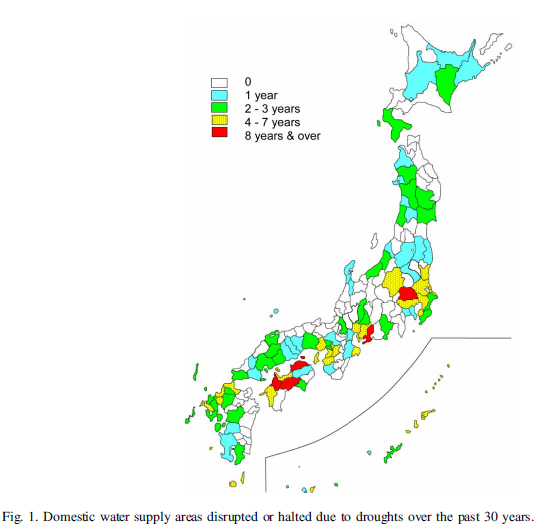Japan’s Climate Change Preparedness an Example for Asian Countries
Published on by Dr Cecilia Tortajada, Honorary Professor at the University of Glasgow, UK in Academic
Japan’s Climate Change Preparedness an Example for Asian Countries
By Cecilia Tortajada

To understand Japan’s complex relationship with water, we must first turn to its topography. Nearly three-quarters of Japan’s land is mountainous, which forms the basis of its steep and short rivers. This limits the amount of rainwater that can be captured before it flows into the sea. As a nation that receives intense rainfall during specific periods of the year (rainy season from June to July and typhoon season from August to September), Japan has traditionally suffered from extreme floods.
In addition, Japan’s population is concentrated in areas with low elevation. Alluvial plains—areas lower than the flood water level of a flooded river—account for only 10 percent of the total land area. Yet, more than 50 percent of the population and 75 percent of the gross assets are concentrated in these plains. Tokyo, the capital city of Japan, is also built on alluvial plains. In fact, 13,120 square kilometers of Tokyo’s area is in the “zero-meter zone,” referring to land where the elevation is at or below sea level.
DROUGHTS AND FLOODS IN JAPAN
The high concentration of the Japanese population in small habitable areas has made Japan historically vulnerable to droughts. Water supply areas affected by drought at least once in the past 30 years are shown on the map.
Exhibit: Areas Affected by Droughts Over the Past 30 Years

Prior to Japan’s modernization period, most of Japan’s water shortages were caused by severe droughts: 1939 Lake Biwa, 1964 Tokyo Olympics, 1967 Nagasaki, 1973 Takamatsu, and 1978 Fukuoka are some of the examples. According to a meta-analysis of Japan’s droughts from 1902 to 2009, the most severe drought took place from 1939 to 1941, lasting for 666 days. This drought very seriously affected water supply, electricity, hydropower generation, factories, railway and marine transportations. It was even considered the reason for the nationalization of major industries.
A more recent example is the nationwide drought that began in spring and ended in mid-September of 1994. The continuing low rainfall had deteriorated the water quality of major rivers near Lakes Sagami, Tsukui and Tanzawa and forced the rationing of water supply. Water rationing began in June in the Kiso River basin and spread to other districts. In the most extreme cases, water for irrigation and industrial use was rationed to a maximum of 65 percent—and 35 percent in the case of domestic uses. Rainfall started in September, and water rationing was relaxed and finally lifted in November.
Japan has also been fighting floods for centuries, and its evolving flood management has been documented extensively. The Tokyo that we know today is a product of engineering of the Tone River to the east and the Arakawa River to the west during the Tokugawa era (1603–1867). To avoid disasters in Tokyo’s east lowlands, the Arakawa Channel and Edogawa Channel and a reclamation land at Kasai were constructed. Dr. Nobuyuki Tsuchiya, chairperson of Japan River Restoration Network, warns against the current false sense of security in Tokyo, stressing that simulations have shown that there is a high probability of floods affecting lowlands and localities with lower height of dykes on the left side of the Arakawa River. He predicts that, as sea level rises due to climate change, in times of high tides, Edogawa city (one of Tokyo’s wards) could be flooded within two days. In light of the high population density in eastern lowlands, he urges the population to remain vigilant toward natural disasters.
WHAT CAN BE DONE?
Given the extreme risks of floods, extensive infrastructure development as well as forested areas, or green dams, have become essential elements for flood management in the country. The strong support toward forest management for water management primarily comes from the civil society and has largely been shaped by the media rather than academia.
Forests cannot replace dams or vice versa: They complement each other. Dams continue to be constructed and, at the same time, policies, laws and regulations are enacted, promoting integrated forest and water management at the national level.
Coming back to extreme events such as droughts and floods, the Bureau of Waterworks, under the Tokyo Metropolitan Government, has planned for mitigation and adaptation measures in the face of climate change impacts on waterworks. It estimates that the number of days with heavy rain (100 mm or more per day) is expected to increase to up to 10 days per year in the next 100 years.
Mitigation measures include use of renewable energy, forest conservation and drainage infrastructure for leakage prevention. With respect to adaptation measures, not surprisingly, the National Plan for Adaptation to the Impacts of Climate Change also considers natural disasters.
Japan has been affected by extreme events such as droughts and floods throughout its history, which has made its institutions and its society aware of the importance of preparedness. With climate variability and change, these events are only expected to increase.
CAN ASIA LEARN FROM THE JAPAN EXPERIENCE?
The level of preparedness shown by Japan can be a lesson for numerous countries in the region—and globally—that are still to plan or are planning for the impacts resulting from changing climate.
There are numerous lessons countries in Asia can learn from Japan, including applied knowledge on hydrology, water resources management, management of droughts and floods, and public awareness and education for disaster prevention. However, in terms of adaptation in the region, just one example suffices. In the 1970s, Japan realized the importance of understanding water resources as part of the entire hydrological system rather than trying to control them by means of infrastructure alone. The pioneering work of Professor Yutaka Takahasi, the most renowned hydrologist of Japan, was essential for the country to accept the then path-breaking concept of water management at the basin level. Over the years, this has proven to be critical in achieving a more efficient management of water resources, including for floods and droughts. More than 40 years later, this concept has still not been implemented in most of the developing world.
Dr. Cecilia Tortajada is senior research fellow, Institute of Water Policy, Lee Kuan Yew School of Public Policy, Singapore, and editor-in-chief, International Journal of Water Resources Development. She has been an advisor to major international institutions like FAO, UNDP, JICA, ADB, OECD and IDRC, and has worked in countries in Africa, Asia, North and South America and Europe on water and environment-related policies. She is a member of the OECD Initiative in Water Governance .
This article was published by BRINK ASIA, June 6, 2018
Media
Taxonomy
- Resource Management
- Water Resource Management
- Drought
- Flood Management
- Water Resource Management
- Water Well Casing
- Flood management
- Flood damage
- flood protection
1 Comment
-
Indeed, commendable efforts....